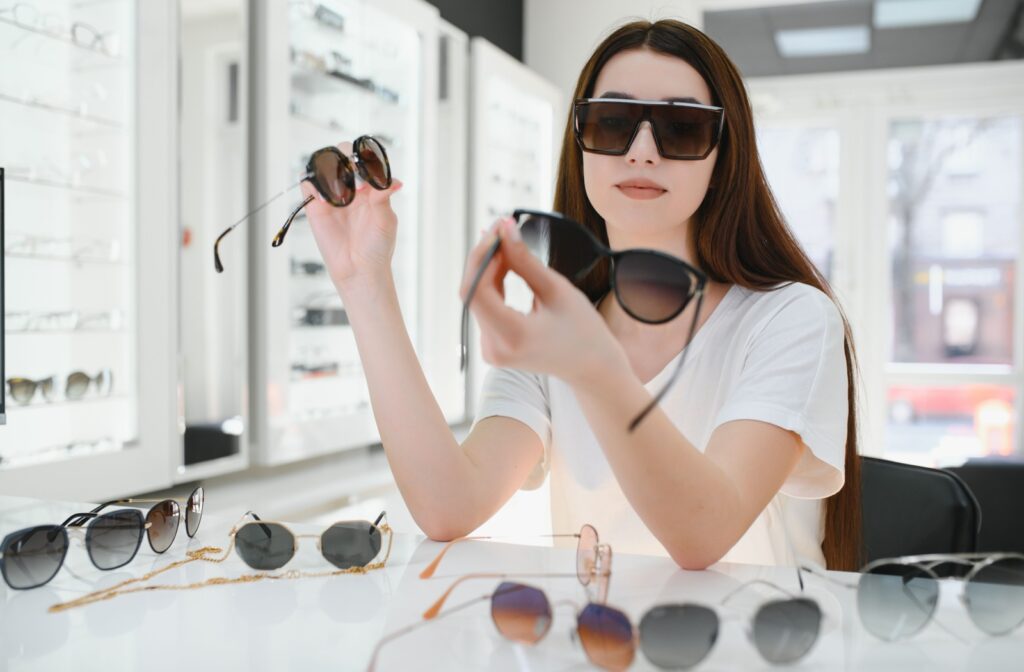Sunglasses are more than just a style statement—they’re a key tool for protecting your eyes from harmful UV rays. If you spend time outdoors, a good pair of sunglasses means the difference between eye strain and clear vision. However, not all sunglasses are created equal, and the different features determine how well they’ll suit your needs.
Some sunglasses are non-polarized, while others are polarized. Polarization helps the lens filter out glare to prevent significant discomfort when you’re outdoors. However, they also make it more difficult to read most screens or devices. An informed choice is key to finding a pair of sunglasses that meets your unique lifestyle.
The Risks of UV Exposure
UV exposure poses several serious threats to your eye health. It damages the delicate structures throughout your body, including the eyes, and slowly increases the risk of all kinds of problems. Prolonged UV exposure can lead to:
- Cataracts, which cloud your natural lens and impair your vision.
- Age-related macular degeneration, the gradual loss of central vision.
- Photokeratitis, also known as eye sunburn, causes temporary but painful vision problems.
- Growths on the eye, such as pterygium (a non-cancerous tissue growth).
Sunglasses act as a protective shield, reducing exposure and minimizing these risks. UV protection has nothing to do with avoiding temporary discomfort. It’s all about keeping your eyes protected when you’re outdoors and lowering the risk of these conditions.
Beyond offering protection, sunglasses can improve your comfort while outdoors. High-quality UV-blocking sunglasses make a significant difference in preserving your long-term vision while adding a layer of comfort to daily life.
Polarized vs. Non-Polarized Lenses Explained
When shopping for sunglasses, you’ll notice that lenses are typically labeled as either polarized or non-polarized. While both types offer UV-blocking properties, their use and benefits vary.
Polarized Lenses
Polarized lenses use a special chemical coating or filter built into the lens. It filters out horizontal glare from reflective surfaces outside like snow, water, metal, and even the pavement. By eliminating glare, these lenses provide crisp, clear vision and reduce eye strain.
These lenses make most outdoor activities significantly easier on the eyes. They’re especially helpful in high-glare situations and are great for reducing discomfort on bright, sunny days.
However, it’s important to note that UV protection and polarization are 2 separate features. Polarized lenses don’t automatically have UV-blocking abilities—you’ll need to look for lenses that offer both polarization and UV protection.
Non-Polarized Lenses
Non-polarized lenses don’t include this built-in glare-reducing property. They’re a simpler—and often more budget-friendly option. If you don’t spend too much time in high-glare conditions, these lenses should work well for your day-to-day needs. However, you’ll still need to make sure you buy a pair that blocks 100% of UV rays.

The Advantages of Wearing Polarized Sunglasses
Polarized sunglasses are often a great choice for people who spend significant amounts of time outdoors. They offer benefits such as:
- They reduce glare from shiny surfaces like water, snow, and car windshields.
- The lenses enhance color, contrast, and overall visual clarity.
- They decrease eye fatigue, helping you stay comfortable outdoors for longer periods.
If you spend significant time in the sun—especially near reflective environments—the comfort and visual enhancement can make all the difference.
However, it’s worth noting that they aren’t “better” than non-polarized lenses. They’re designed to help reduce glare and improve comfort. Non-polarized lenses can still be helpful, especially if you rely on screens and digital devices when you’re outdoors.
What to Expect With Polarized Lenses
One downside of polarized lenses is how they interact with screens. Devices like smartphones, tablets, and laptop screens use polarized light to display their images. This can cause issues when you’re wearing polarized sunglasses, as the lenses sometimes block out some of the visible light.
This is also true for certain car dashboards and other electronic displays. If you rely on these to get through your day, polarized lenses may not be ideal. It helps to alternate between polarized and non-polarized sunglasses based on what you need at the moment.
Your New Pair of Sunglasses Awaits
Whether you choose polarized or non-polarized lenses, sunglasses are an important addition to your life. Polarized lenses give you boosted comfort and clarity, whereas non-polarized options focus on essential UV protection without the extras. Both protect your eyes, but it’s about matching your choice to your lifestyle and the environments you explore.
That’s why our team at Total Vision Carlsbad Plaza offers both polarized and non-polarized sunglasses! We’ll help you find a style and lens that meets your needs. Book an appointment with us today—your new pair of sunglasses awaits.



